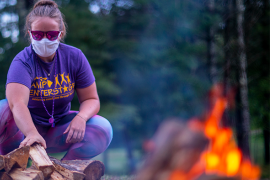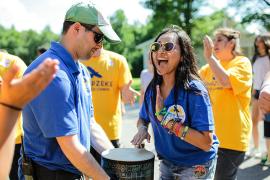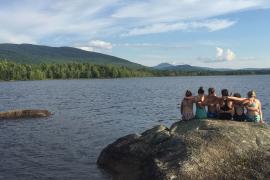Over the last six weeks, ACA staff have received a great number of questions about COVID-19 and how to plan for summer 2022. In response, we sat down with ACA’s volunteer medical advisor Laura Blaisdell, MD/MPH, FAAP, to answer your questions. As you are aware, the pandemic has continued to rapidly evolve, most recently — with the arrival of the Omicron variant. Dr. Blaisdell’s responses are her best answers based on the information that is available today. ACA will continue to monitor the situation and provide resources and up-to-date guidance from the CDC as we collectively plan for summer 2022.
One of the more frequently asked questions we receive is about the role of the Field Guide in the 2022 season. At the beginning of the pandemic, ACA worked with medical and public health experts to develop the Field Guide to provide specific resources for camps when guidance and best practice was changing rapidly. We anticipate the Centers for Disease Control and Prevention (CDC) and the American Academy of Pediatrics (AAP) will continue to provide up-to-date COVID-19 guidance for youth-serving organizations and schools. While the Field Guide will continue to be a resource, camps should look toward the CDC and local public health regulations and guidelines for the most up-to-date practices for 2022. ACA will continue to work closely with the CDC and the AAP, monitor for newly released guidance, and continue to update our membership on guidance changes.
Looking ahead to summer 2022, we know that what kids need today more than ever is camp. We also know that camps are focused on serving as many participants and families as possible. Dr. Blaisdell’s answers to your questions should provide you with current insights on how the pandemic may impact camp operations this coming summer. ACA will continue to provide updated information as it becomes available.
1. Are all the nonpharmaceutical interventions (NPIs) still relevant?
Camps should follow their local and state guidelines for the prevention and control of COVID-19. In the absence of specific local guidance, camps can utilize the Centers for Disease Control and Prevention's (CDC) Guidance for Operating Youth and Summer Camps: Readiness and Planning Tool to guide planning for the 2022 season. The state of the pandemic both nationally and locally continues to be fluid and cyclic in its nature and camps must be prepared to operate with contingency plans that reflect the uncertainty of where COVID-19 rates are in the summer of 2022.
NPIs continue to be effective and important tools in the prevention and mitigation of COVID-19 in the summer camp setting. Diligent, multilayered use of these interventions, both with and without vaccination, has been shown to safely allow camps and schools to operate. Masking, distancing, ventilation, hygiene, disinfection, testing, and cohorting will continue to play a role in our summers to varying degrees, implementation and circumstances.
2. What do we know about the Omicron variant and if it will impact summer 2022? In general, what should we do to plan for variants of SARS-CoV-2?
In late November, a new variant of SARS-CoV-2, B1.1.529, was reported to the World Health Organization after it was detected by South African scientists. This new variant named Omicron was determined to be a variant of concern because of its new and numerous mutations. Scientists fully expect that SARS-CoV-2 will continue to mutate and develop new variants; however, the concerning questions about any new variant is if it spreads more easily and causes more severe illness or if treatments and vaccines will work against it.
Scientists are working around the clock to answer these questions, but some preliminary data has revealed that Omicron likely spreads more easily than the original SARS-CoV-2 virus. Early reports from experience in South Africa indicate patients seem less ill and that prior COVID-19 infection was not wholly protective against reinfection with Omicron. Pfizer, in a small study of samples in a laboratory, reported fully vaccinated (two doses) samples demonstrated much lower levels of antibodies protecting against Omicron than against early versions of the virus — but that booster doses greatly restored the ability to prevent COVID-19. One must take caution in placing too much stock in this early evidence — more robust research that science believes reflects the reality of Omicron is underway and will be available in the coming weeks.
There is certainty in this: NPIs that worked before will work again for this and future variants. No variant to date has acquired the ability to evade masks, jump further than six feet, or learned to shrug off soap. Being outside still decreases transmission and tests continue to detect Omicron (however, we are watching this closely). And, vaccines will no doubt continue to provide meaningful protection against severe disease, hospitalization, and death.
So what should camps do to plan for a healthy 2022? Keep your toolbox full and at the ready. Camps opened safely last year — and can do so again if prepared for increased layering of NPIs when there is high community transmission or positive cases of COVID-19 in camp. As always, it is easier to manage COVID-19 cases prior to camp or at the door than during a camp session — so plan on a testing strategy that reflects the nature and risks of COVID-19 in your community. Many wish for a pre-COVID-19 camp experience, and I acknowledge this desire. However, the reality of variants and low vaccine rates allowing for continued transmission throughout the US will postpone such a hope from becoming reality anytime soon.
3. What role will testing play in camp operations for summer 2022? Does this look different at day camp and overnight camp?
Testing continues to play an important role in surveillance and early detection of COVID-19 and camps should plan to partner or provide for testing in summer 2022. The school year experience has provided additional support as to the power of this tool to maintain operations during and between surges. Day camps can look to their state’s school testing experience as a model for their testing programs. Overnight camps should continue to consider a prearrival and post-arrival testing cadence that is reflective of their camps risks and duration. It is always desirable to "catch" COVID-19 before or quickly after arrival. Camps in the 2021 season demonstrated the ability to roll down NPIs after testing returned negative for their communities, although transience in or out of the camp "bubble" must be considered as sources of potential reintroduction of COVID-19. Camps must remember that testing interpretation is complex and they are encouraged to partner with a healthcare professional for assistance.
4. What are your recommendations for a camp’s policy on staff vaccinations for summer 2022?
Vaccinations continue to provide safe, powerful protection against transmission, disease, and death from COVID-19. This is why the CDC recommends COVID-19 vaccines for all eligible persons. Additionally, current federal quarantine requirements exempt vaccinated persons from quarantine, which helps ensure continuity of programming. Vaccinations for other infectious diseases provide the foundation for gathering safely and on-the-whole are strongly recommended as a safety and public health standard.
Implied in this question is the role and legality of a vaccine mandate. Many are watching closely OSHA’s Emergency Temporary Standard (ETS) stating all private employers with 100 or more employees (whether full time, part-time, temporary, or provisional) must create, implement, and enforce a policy regarding vaccination against COVID-19 and/or testing. Many legal experts recommend that employers continue to prepare to follow the requirements of the ETS while litigation continues.
Camps should also review their state policy regarding vaccination exemptions, because while all states allow medical vaccine exemptions, not all states allow religious or philosophical exemptions to required vaccines. Camp should clearly communicate their expectations for staff vaccination status (see discussion of definition of fully vaccinated below) regardless of the ETS and determination of mandated status. Camps may also consider required behaviors for unvaccinated staff such as testing more frequently, staff assignment with less face-to-face interaction, and/or staying on campus during session.
5. What are your recommendations for a camp's policy on camper vaccinations for summer 2022?
Camps should have vaccination policies for campers that align with governing bodies recommendations, such as the CDC or the American Academy of Pediatrics (AAP). Routine childhood vaccination levels have not yet recovered to their pre-pandemic protective rates and while providers are working hard to get families caught up before outbreaks of other diseases like pertussis or measles return. Camps can and should play an important role in protecting children from vaccine-preventable diseases and their communities from other outbreaks beyond COVID-19.
The AAP recommends COVID-19 vaccination for all children and adolescents five years of age and older who do not have contraindications using a COVID-19 vaccine authorized for use in their age. Children with previous infection or disease with SARS-CoV-2 should receive COVID-19 vaccination according to CDC guidelines.
Camp policies regarding COVID-19 vaccination will no doubt vary in the 2022 season. While some school districts are requiring COVID-19 for ages 12 and up for school attendance, many are nowhere close to such a requirement. Camps should monitor their state and local public health requirements and guidance on vaccination and begin to assess the potential vaccination status of their camp attendees. Higher vaccination rates may allow camps more robust programming choices that lower rates will not. Additionally, camps must consider their quarantine policies and facilities as unvaccinated campers must quarantine with all COVID-19 exposures. Camps will most likely determine their camper COVID-19 vaccination policy without edicts from their state or industry governing bodies. To be considered as part of a camp COVID-19 vaccination policy, inputs should include among others, vaccination incentives/disincentives in program participation, the need for increased testing for unvaccinated campers, the impact and consequences of a vaccine requirement and determination of vaccine exemption policies.
6. What does “fully vaccinated” mean now? Both Pfizer and Moderna shots or a single Johnson & Johnson (J&J) shot within a certain time frame? What about boosters? If someone got vaccinated in April or May 2021, what should they do in 2022?
Full vaccination continues to be defined by the CDC as being two weeks after a second dose in a two-dose series (e.g. Pfizer or Moderna) or two weeks after a single dose in a one-dose series (J&J). This definition increasingly is being shown to not be the optimal protection, driving the CDC recommendations of all persons aged 16 and older to get a booster if they are over six months from their primary series. Thus, a change in the definition of fully vaccinated to include a third shot is likely more a question of if, not when. Access to boosters remains stable in the US, so camps should have enough time to get staff and campers boosted if the definition of fully vaccinated changes in the upcoming months.
7. Has quarantine guidance changed since last summer? If a camper or staff member is showing symptoms or tests positive how long should we require quarantining? Does this look different at day camp and overnight camp?
Quarantine and isolation are determined by local and state public health authorities and apply to all persons and organizations within their jurisdiction, regardless of day or overnight camping designation.
Quarantine — the period of time of stay-at-home after close contact to a case with COVID-19 — has changed over the course of the pandemic. Currently, all people must quarantine for 14 days unless they are fully vaccinated. Quarantines may be shortened by local or state public health authorities other options, such as 10 days without testing or after day 7 upon receiving a negative test. Camps should be aware of where to find their states' quarantine definitions and stay up to date.
Isolation — the period of time that a person diagnosed with COVID-19 must stay at home — has remained stable over the pandemic at 10 days, with day 0 being the first day of symptoms (or positive test if no symptoms). Camps should continue to report all positive cases of COVID-19 and work with their local public health authorities, who will assist in determining lengths of quarantines and isolations should camps have positive cases.
Camps should be aware of domestic and international travel guidance, which also uses the term "quarantine" after travel to or within the US by the vaccination status of the traveler. Domestic and international travel guidance can change quickly in response to the pandemic’s fluctuations. Quarantine in this sense is assuming travelers on public transportation may have likely been exposed and mandate a period after travel to test and stay removed from the public.
8. If my state and county are not currently offering guidance related to NPIs, what is your recommendation for mitigating spread of SARS-CoV-2 leading up to and during summer 2022?
Camps should at a minimum utilize the CDC's Guidance for Operating Youth and Summer Camps: Readiness and Planning Tool to guide planning for the 2022 season. The CDC will likely update this tool as we get closer to opening next summer!
Laura Blaisdell, MD/MPH, FAAP, is a pediatrician, researcher and advocate. For 20 years, she has consulted in camp medicine, while serving as medical director at Camp Winnebago. She currently is vice president of Maine AAP and a founding member of Maine Families for Vaccines. Dr. Blaisdell researches parental vaccine hesitation with Maine Medical Center. Additionally, she served site director for the National Children’s Study, as chair of the Institutional Review Board (IRB) at MMC, as chief of pediatrics at InterMed, and currently is Trustee to Mercy Hospital in Portland. She is an assistant professor at Tufts University School of Medicine. She resides in South Portland, ME, with her two sons and husband, Andy Lilienthal.
Photo: peterschreiber.media / iStock / Getty Images Plus
The views and opinions expressed by contributors are their own and do not necessarily reflect the views of the American Camp Association or ACA employees.




